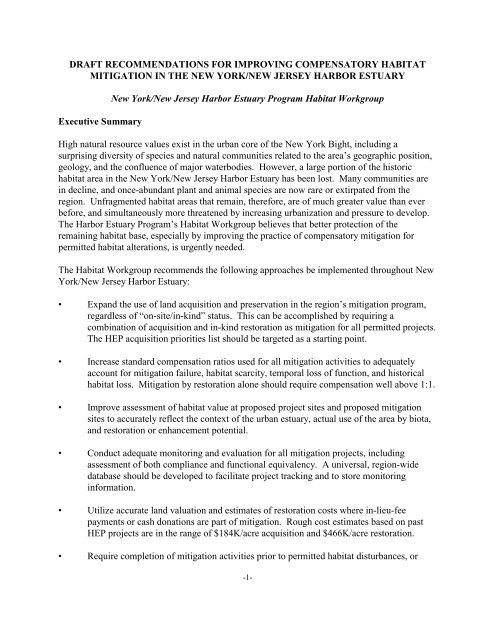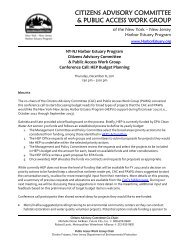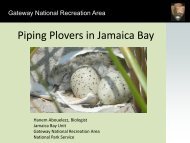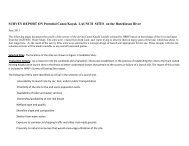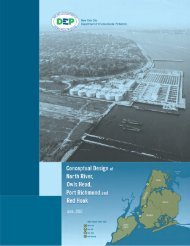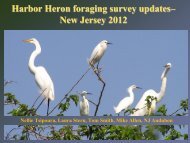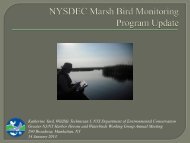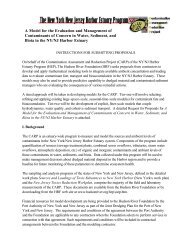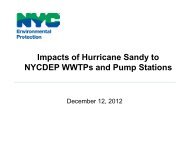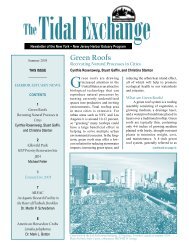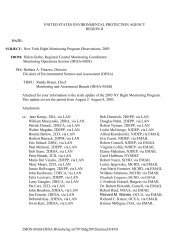DraftMitigation .pdf - New York-New Jersey Harbor Estuary Program
DraftMitigation .pdf - New York-New Jersey Harbor Estuary Program
DraftMitigation .pdf - New York-New Jersey Harbor Estuary Program
You also want an ePaper? Increase the reach of your titles
YUMPU automatically turns print PDFs into web optimized ePapers that Google loves.
DRAFT RECOMMENDATIONS FOR IMPROVING COMPENSATORY HABITAT<br />
MITIGATION IN THE NEW YORK/NEW JERSEY HARBOR ESTUARY<br />
Executive Summary<br />
<strong>New</strong> <strong>York</strong>/<strong>New</strong> <strong>Jersey</strong> <strong>Harbor</strong> <strong>Estuary</strong> <strong>Program</strong> Habitat Workgroup<br />
High natural resource values exist in the urban core of the <strong>New</strong> <strong>York</strong> Bight, including a<br />
surprising diversity of species and natural communities related to the area’s geographic position,<br />
geology, and the confluence of major waterbodies. However, a large portion of the historic<br />
habitat area in the <strong>New</strong> <strong>York</strong>/<strong>New</strong> <strong>Jersey</strong> <strong>Harbor</strong> <strong>Estuary</strong> has been lost. Many communities are<br />
in decline, and once-abundant plant and animal species are now rare or extirpated from the<br />
region. Unfragmented habitat areas that remain, therefore, are of much greater value than ever<br />
before, and simultaneously more threatened by increasing urbanization and pressure to develop.<br />
The <strong>Harbor</strong> <strong>Estuary</strong> <strong>Program</strong>’s Habitat Workgroup believes that better protection of the<br />
remaining habitat base, especially by improving the practice of compensatory mitigation for<br />
permitted habitat alterations, is urgently needed.<br />
The Habitat Workgroup recommends the following approaches be implemented throughout <strong>New</strong><br />
<strong>York</strong>/<strong>New</strong> <strong>Jersey</strong> <strong>Harbor</strong> <strong>Estuary</strong>:<br />
• Expand the use of land acquisition and preservation in the region’s mitigation program,<br />
regardless of “on-site/in-kind” status. This can be accomplished by requiring a<br />
combination of acquisition and in-kind restoration as mitigation for all permitted projects.<br />
The HEP acquisition priorities list should be targeted as a starting point.<br />
• Increase standard compensation ratios used for all mitigation activities to adequately<br />
account for mitigation failure, habitat scarcity, temporal loss of function, and historical<br />
habitat loss. Mitigation by restoration alone should require compensation well above 1:1.<br />
• Improve assessment of habitat value at proposed project sites and proposed mitigation<br />
sites to accurately reflect the context of the urban estuary, actual use of the area by biota,<br />
and restoration or enhancement potential.<br />
• Conduct adequate monitoring and evaluation for all mitigation projects, including<br />
assessment of both compliance and functional equivalency. A universal, region-wide<br />
database should be developed to facilitate project tracking and to store monitoring<br />
information.<br />
• Utilize accurate land valuation and estimates of restoration costs where in-lieu-fee<br />
payments or cash donations are part of mitigation. Rough cost estimates based on past<br />
HEP projects are in the range of $184K/acre acquisition and $466K/acre restoration.<br />
• Require completion of mitigation activities prior to permitted habitat disturbances, or<br />
-1-
equire performance bonds for a compensation ratio in excess of 1:1 using cost per acre<br />
estimates that provide disincentive to walking away from the bond.<br />
• Require appropriate qualifications for consultants and contractors that design and<br />
implement mitigation projects, and track their success rates. The issuance of future<br />
permits should be tied to the mitigation track record of involved personnel.<br />
• Increase enforcement of permit compliance, including additional site work when required<br />
conditions are not achieved. Stiff penalties should be assessed for non-compliance.<br />
Although the Habitat Workgroup would prefer to work primarily towards achieving no further<br />
habitat loss, we recognize the realities of this urban estuary. Development will occur, and<br />
compensatory mitigation is the major tool used to justify permitting development. This system<br />
fits into a much larger universe of issues that require examination and resolution. In the<br />
meantime, we need to get more ecological value back when this system is used - and it is being<br />
used, all the time. Our recommendations are not meant to promote mitigation as a fundamentally<br />
good tool. We simply want to start stemming the flood tide of habitat loss in the <strong>Harbor</strong> <strong>Estuary</strong><br />
by making loss less easy to justify, and by increasing our return on losses when they occur.<br />
-2-
INTRODUCTION<br />
Assumptions<br />
The fact that the HEP Habitat Workgroup is making recommendations for mitigation should not<br />
be construed to mean that we support increased filling, dredging, construction, channelization, or<br />
any other activity normally resulting in mitigation. Nor should it be interpreted that we believe<br />
restored, enhanced, created, and other manipulated areas are equivalent to natural habitats, and<br />
thus may be traded like currency. Our recommendations are not meant to promote an increase in<br />
habitat mitigation in general, but to improve the practice of mitigation as it is already being used.<br />
Our primary belief is that no new development should be permitted in any remaining<br />
unfragmented, unique, high function, or critical habitat areas of the <strong>New</strong> <strong>York</strong>/<strong>New</strong> <strong>Jersey</strong><br />
<strong>Harbor</strong> <strong>Estuary</strong>. However, we recognize the reality of this highly used, densely populated region,<br />
where development will still occur and some habitat impacts are appropriate and inevitable.<br />
Underlying these recommendations is the assumption that “sequencing” of mitigation is<br />
occurring in all cases: the first options considered for all projects are 1) avoiding impacts, and 2)<br />
minimizing impacts.<br />
Our current knowledge level is insufficient to mitigate certain types of habitat, therefore, loss of<br />
these habitats should not be permitted (Zedler & Shabman, 2001). Habitats falling into this<br />
category may include areas with element occurrences documented by Natural Heritage <strong>Program</strong>s;<br />
areas supporting state and federally-protected species; state, locally-, or federally-designated<br />
significant habitat areas; and other examples of unique or rare natural communities and<br />
populations. State-of-the-art knowledge and restoration methods are adequate for restoration of<br />
intertidal salt marsh and some freshwater wetlands, stabilization of dunes and riparian areas, and<br />
creation of some grassland habitats. Many other habitats, such as subtidal and benthic areas,<br />
submerged aquatic vegetation, freshwater bogs and fens, interdunal swales, mature upland<br />
forests, and forested wetlands, are virtually irreplaceable with our current knowledge and<br />
techniques. Our ability to adequately restore, recreate, or replace specific habitat types needs to<br />
be a critical factor in decision making about whether to issue a permit justified by compensatory<br />
mitigation.<br />
Definitions<br />
Wherever restoration mitigation occurs, the restored habitat should replace the lost habitat in<br />
kind. This means, for example, it is not appropriate to provide restoration of low salt marsh in<br />
compensation for permitted loss of forested wetland. If in-kind restoration is not required (or we<br />
permit the loss of habitats we are yet unable to restore), cumulative shifts will occur in the<br />
landscape mosaic and, over time, some communities may be permanently lost. Although all<br />
habitat types will each provide some functions and values, the loss of a particular type impacts<br />
the specific species and populations adapted to its resources. Out-of-kind restoration can not<br />
adequately compensate these specific losses.<br />
-3-
The terms “off-site” and “on-site” must also be clarified. The most traditional thinking treats the<br />
term “on-site” quite literally, encouraging mitigation work adjacent to or contiguous with the<br />
permitted project. Although this is meant to retain habitat area and function at that location, a<br />
restrictive siting policy can result in inappropriate conditions that prevent long-term viability of<br />
the compensation habitat. Moreover, this type of siting is frequently not feasible in the <strong>Estuary</strong>’s<br />
urban core where available land is scarce and expensive. Therefore, the Workgroup supports a<br />
more flexible siting policy where “off-site” compensation may be acceptable. A more flexible<br />
policy, however, should not mean that any location is acceptable. It is not appropriate to<br />
compensate a permitted activity in the Bronx by conducting restoration in a <strong>New</strong> <strong>Jersey</strong><br />
mitigation bank. Rather, working “off-site” means that, although an appropriate mitigation site<br />
will necessarily be located within the same ecosystem or watershed, absolute proximity to the<br />
impacted site will not be the primary factor used for identification.<br />
COMPENSATORY MITIGATION<br />
Statutory and Regulatory Context<br />
The regulation of natural resource and environmental impacts occurs within a diverse statutory<br />
and regulatory framework. General consideration of impacts on fish and wildlife resources and<br />
on the environment is required by the federal Fish and Wildlife Coordination Act and the<br />
National Environmental Policy Act (NEPA). The Coastal Zone Management Act (CZMA)<br />
requires consistency of federal and permitted activities in the coastal zone with approved state<br />
coastal management plans, which contain policies to protect coastal natural resources.<br />
Both NEPA and CZMA have state counterparts: In <strong>New</strong> <strong>York</strong>, the Department of Environmental<br />
Conservation (NYSDEC) administers the State Environmental Quality Review Act (SEQR) and<br />
Department of State (NYSDOS) Division of Coastal Resources administers the state Coastal<br />
Management <strong>Program</strong>; in <strong>New</strong> <strong>Jersey</strong>, the Department of Environmental Protection (NJDEP)<br />
Land Use Regulation <strong>Program</strong> administers the Rules on Coastal Zone Management.<br />
There is specific reference to mitigation in the Endangered Species Act, which requires that<br />
alternatives be considered, and that actions to “minimize and mitigate” impacts to protected<br />
species are taken. However, the majority of mitigation as we understand it occurs in the context<br />
of the U.S. Army Corps of Engineers (USACE) Rivers and <strong>Harbor</strong>s Act Section 10 and Clean<br />
Water Act Section 404 permit programs. Clean Water Act Section 404 is jointly administered by<br />
USACE and the U.S. Environmental Protection Agency (EPA): USACE grants Section 404<br />
permits, while EPA is responsible for developing program guidelines. States with EPA-approved<br />
programs have the authority to issue their own Section 404 permits.<br />
Although the Section 404 program provides the main framework for compensatory wetland<br />
mitigation, no specific reference to this practice occurs, nor is it explicitly authorized. EPA’s<br />
1980 404(b)(1) guidelines include the first mention of compensatory mitigation for wetland<br />
disturbance “Habitat development and restoration techniques can be used to minimize adverse<br />
-4-
impacts and to compensate for destroyed habitat.” More recently, compensatory mitigation has<br />
been driven by the “no net loss” policy goal expressed in the 1990 USACE and USEPA<br />
Mitigation MOA, and subsequent congressional establishment of this goal in the Water<br />
Resources Development Act of 1990. “No net loss” and mitigation, however, are not specific<br />
regulatory requirements.<br />
In the HEP region, additional regulatory authorities relevant to compensatory mitigation include<br />
the states of <strong>New</strong> <strong>York</strong> and <strong>New</strong> <strong>Jersey</strong>. In <strong>New</strong> <strong>York</strong> State, NYSDEC administers separate state<br />
tidal and freshwater wetlands permit programs, and a Use and Protection of Waters permit<br />
program (Stream Protection <strong>Program</strong>). The goal of <strong>New</strong> <strong>York</strong>’s Freshwater Wetlands <strong>Program</strong> is<br />
to achieve no net loss of wetlands, while for the Tidal Wetlands <strong>Program</strong> the goal is a net<br />
increase. It is possible in <strong>New</strong> <strong>York</strong> State for a local government to obtain authorization to run<br />
its own Freshwater Wetlands permit program. In addition, DEC administers the Water Quality<br />
Certification <strong>Program</strong> authorized under Section 401 of the Clean Water Act that requires<br />
applicants for Section 404, Protection of Waters, Tidal Wetlands, and Freshwater Wetlands<br />
permits to first obtain a Section 401 ceritification.<br />
In <strong>New</strong> <strong>Jersey</strong>, wetlands are regulated and protected under the Wetlands Act of 1970 and the<br />
Freshwater Wetlands Protection Act. In April 1994, the State of <strong>New</strong> <strong>Jersey</strong> officially assumed<br />
Clean Water Act Section 404 authority for its freshwater wetlands program, one of only two<br />
states so far to have done so. The State program, administered under the Freshwater Wetlands<br />
Protection Act, was modeled after the Section 404 program, but it regulates activities not covered<br />
under 404, such as the regulation of upland buffers. In <strong>New</strong> <strong>Jersey</strong>, USACE basically regulates<br />
activities in tidal wetlands and other tidal aquatic sites.<br />
NJDEP Land Use Regulation <strong>Program</strong> (LURP) administers permit programs under the wetlands<br />
protection acts, as well as under the Coastal Area Facility Review Act (CAFRA) and the<br />
Waterfront Development Act. The CAFRA program regulates development within <strong>New</strong> <strong>Jersey</strong>’s<br />
designated coastal zone, while the Waterfront Development Act applies to waterfront areas<br />
outside the CAFRA area. The LURP is also responsible for <strong>New</strong> <strong>Jersey</strong>’s Section 401 Water<br />
Quality Certification <strong>Program</strong>. NJDEP’s Bureau of Tidelands Management administers a<br />
riparian grant program for currently or formerly tidally flowed lands under the Tidelands Act.<br />
USACE recently independently released a new regulatory guidance letter to its districts regarding<br />
compensatory mitigation under Clean Water Act Section 404 and Rivers and <strong>Harbor</strong>s Act<br />
Section 10. The new guidance purports to respond to some of the criticisms of the National<br />
Research Council (2001; see below). Agency and stakeholder response to the USACE regulatory<br />
guidance letter is ongoing. The letter may be compatible with HEP efforts to increase the use of<br />
preservation, and appropriate off-site/out-of-kind compensation within an reasonable watershed<br />
context. It is possible that the ensuing debate among affected agencies and stakeholders over the<br />
provisions of the new guidance may provide a context for discussion and incorporation of the<br />
HEP recommendations.<br />
Mitigation Theory - The Status Quo<br />
-5-
The term “compensatory mitigation” refers to the practice of requiring compensation for the<br />
natural resource losses that will result from State- or federally-permitted activities. Most<br />
frequently these activities involve the restoration or creation of wetlands in compensation for<br />
areas of wetland fill. The logic behind compensatory mitigation assumes that efforts to<br />
“sequence”, i.e., first avoid, and second minimize, a project’s impacts have already been made.<br />
Generally, the permittee is encouraged to conduct mitigation both “on-site” and “in-kind”. In<br />
other words, the mitigation site should be located adjacent to or contiguous with the project site,<br />
and should replace or create the same habitat type as the one impacted by the permitted activity.<br />
Standard mitigation theory prioritizes possible activities in the following order: restoration,<br />
creation, enhancement (of specific ecological functions), and finally, preservation. Restoration is<br />
most highly favored because the basic characteristics of the target habitat often remain, and the<br />
suitability of the site for that habitat is proven. Some types of restoration, for example salt<br />
marsh, can be highly successful.<br />
Habitat creation is considered a less attractive option because it involves establishing a habitat<br />
somewhere where there is no precedent for its existence. Habitat creation projects often contend<br />
with high uncertainty, inadequate scientific knowledge, and technological limitations. Creation<br />
may, nevertheless, be favored because in theory the impacted habitat acreage is truly<br />
compensated.<br />
According to standard thinking, enhancement is less favored because there is incomplete<br />
compensation for the impacted acreage - the “enhanced” area was already a functional habitat.<br />
Finally, preservation of habitat, e.g., land acquisition, as mitigation is normally discouraged<br />
because in theory there will result a net loss of habitat value - neither new habitat nor enhanced<br />
function has been added to the impacted watershed or landform.<br />
The nation’s “no net loss” of wetlands directive is represented in mitigation theory by a<br />
compensation ratio of 1:1 (acres restored : acres lost). However, in order to ensure full<br />
compensation for impacted habitat despite the uncertainty and technological limitations of<br />
mitigation actions, it is often recommended that habitat replacement ratios greater than 1:1 be<br />
required. Ratios actually employed have generally ranged from 1:1 to 10:1, depending on the<br />
type of mitigation proposed. According to the prioritization above, restoration mitigations have<br />
required the lowest ratios (about 1:1 to 3:1) because it is assumed that likelihood of success is<br />
high. Conversely, ratios of around 6:1 or higher have been associated with preservation actions.<br />
Many researchers and natural resource managers support linking ratios to site-specific factors<br />
such as the rarity of the impacted habitat, site-specific characteristics, lost ecological functions,<br />
and the aforementioned likelihood of success. Some existing state programs do not stipulate an<br />
across-the-board compensation ratio, but employ habitat evaluation techniques (e.g., HEP, WET)<br />
at each site to determine the functions that must be replaced.<br />
National Research Council Evaluation of Section 404 Mitigation<br />
-6-
In June 2001, the National Research Council’s Committee on Mitigating Wetland Losses<br />
released a study of compensatory mitigation in the United States under section 404 of the Clean<br />
Water Act. A concise summary of study findings is provided by Zedler & Shabman (2001). The<br />
study concludes that the mitigation status quo is not working to the benefit of the natural<br />
environment. The Committee states: “The goal of no net loss of wetlands is not being met for<br />
wetland functions by the mitigation program, despite progress in the last 20 years.” (NRC, 2001)<br />
Although the rate of wetland loss has slowed about 75%, and between 1993 and 2000 an overall<br />
ratio of 1.8 acres of mitigation were required as compensation for each acre permitted, there is<br />
little or no evidence that the decreased rate of wetland loss can be attributed to the mitigation<br />
program under the Clean Water Act (NRC, 2001).<br />
Requiring mitigation for habitat losses is not a given: the percentage of permits issued in which<br />
mitigation was stipulated, based on a review of regional scientific studies, was as low as 13%.<br />
And in terms of mitigating the permitted area lost, the Committee found that although on a<br />
national basis a 78% gain in wetland area should be evident, in reality the actual mitigation areas<br />
attained on-the-ground regionally range from net losses (in almost half the areas studied) to<br />
isolated gains in area as great as 498% (Table 6.1, NRC, 2001).<br />
Findings related to project implementation are alarming: the Committee found that of those<br />
projects specifying mitigation, in some areas as few as 28% of those mitigations required were<br />
ever initiated (Table 6.3, NRC, 2001).<br />
The Committee also found that compliance with the required mitigation ratios was frequently not<br />
achieved. The ratios stipulated in those studies reviewed by the Committee ranged from 1:1 to<br />
2.5:1, but were achieved at as few as 17%, and never greater than 90%, of mitigation sites (Table<br />
6.5, NRC, 2001). This is a 69% average rate of compliance, meaning that a ratio of at least 1.5:1<br />
would be needed to achieve 1:1 compliance on-the-ground (NRC, 2001).<br />
A substantial percentage of permits are not monitored for compliance: as many as 90% in those<br />
studies reviewed by the Committee. With the exception of one area where all sites received one<br />
visit, the percentage not monitored ranged from 49% to 90% in the seven studies reviewed<br />
(Table 6.7, NRC, 2001).<br />
The Committee reviewed eight studies estimating both permit compliance and ecological<br />
equivalency, an aspect of mitigation more difficult to evaluate and achieve. While percent<br />
compliance with permit conditions ranged from 6% to 100%, the number that subsequently met<br />
various ecological criteria ranged from 0 to 67% (Table 6.11, NRC, 2001).<br />
In summary, the Committee found that of the mitigations required, about three-quarters are<br />
actually implemented, and of these, about half ultimately comply with permit requirements for<br />
replacement of wetland area. Finally, only about 20% of mitigation wetlands achieve some<br />
measure of functional equivalency with lost wetlands (NRC, 2001).<br />
-7-
The Committee also outlined additional conclusions about standard mitigation practices: 1) using<br />
a watershed approach to make permit decisions would improve mitigation; 2) performance<br />
expectations have frequently been unclear and thus compliance can not be assured; 3) support for<br />
regulatory decision making is inadequate; and 4) third-party approaches sometimes have<br />
advantages over permittee-responsible mitigation (NRC, 2001).<br />
Much peer-reviewed literature echos the Committee’s conclusions about compensatory<br />
mitigation (see Langis et al., 1991; Moy and Levin, 1991; Munro, 1992; Race and Fonseca,<br />
1996). It is clear that changes must be made in order to stem ongoing losses of wetlands and<br />
other habitat under the guise of compensatory mitigation.<br />
Table 1. Summary of NRC Findings on Wetland Mitigation (based on Table 6.16, NRC, 2001).<br />
Parameter<br />
Number<br />
of Studies<br />
Number<br />
of States<br />
Number<br />
of Permits<br />
Range of<br />
Values<br />
Mean Value<br />
Median<br />
Value<br />
Permits where the<br />
required mitigation<br />
was attempted<br />
8 7 827 28% -100% 76% 70%<br />
Change in wetland<br />
area resulting from<br />
permits with<br />
mitigation<br />
8 5 288+ 92% loss -<br />
44% gain<br />
17% loss 32.5% loss<br />
Required ratio met 19 6 333+ 0 - 100% 58% 53%<br />
Completed<br />
mitigations that are<br />
functionally<br />
equivalent<br />
Sites with<br />
insufficient<br />
monitoring<br />
9 4 268+ 0 - 67% 21% 18%<br />
7 6 550 40% -90% 63% 61%<br />
Evaluation of Freshwater Wetland Mitigation in <strong>New</strong> <strong>Jersey</strong><br />
<strong>New</strong> <strong>Jersey</strong> Department of Environmental Protection (NJDEP) conducted a study in 1999-2000<br />
to examine how many wetlands were created, enhanced, and restored through mitigation<br />
(NJDEP, 2002). Specifically, the study investigated the extent to which approved freshwater<br />
wetland mitigation sites had been constructed in terms of: area achieved, concurrence with<br />
approved plans, and relative ecological quality achieved. Ninety sites (out of 171 approved<br />
mitigation projects in the NJDEP database) were selected, totalling 326 acres of proposed<br />
mitigation area, exhibiting an average proposed size of 3.62 acres and ranging in age from 0.83<br />
years to 12.4 years. Sixty-four percent of the sites were greater than 5 years old (NJDEP, 2002).<br />
-8-
Relative quality was determined through the Wetland Mitigation Quality Assessment (WMQA)<br />
tool developed by NJDEP for their study. The wetland quality value assigned to each site was<br />
based on field observations of hydrology, soils, vegetation, wildlife suitability, site<br />
characteristics, and landscape features (NJDEP, 2002).<br />
In their study, NJDEP found that mitigation, on average, achieved the goal of wetland area<br />
created only 45% of the time (or a ratio of 0.45 acres achieved for each acre proposed). The<br />
range in actual area achieved was 0 to 140%, and was heavily weighted by habitat type: on<br />
average, 92% of proposed emergent wetland acreage was achieved, while only 1% of porposed<br />
forested wetland acreage was achieved. A 48 percent concurrence with designs and permit<br />
specifications was achieved on average (individual concurrence scores ranged from 0% to<br />
100%). In terms of WMQA scores, mitigation sites evaluated met, on average, about half the<br />
criteria indicating a potential to function as natural wetlands over time (NJDEP, 2002).<br />
Mitigation sites with sufficient data to allow calculation of proposed and achieved mitigation<br />
ratios accounted for 234 acres of lost wetlands, with corresponding mitigation of 324 acres<br />
approved. This translates into an average approved mitigation ratio of 1.8:1. However, the total<br />
wetland area achieved through mitigation was actually only 187 acres. Therefore, on average, a<br />
ratio of only 0.78:1 was achieved, in other words, a net loss of 22% over the period 1988-1999<br />
(NJDEP, 2002).<br />
Table 2. Compensation Ratios Proposed and Achieved by Habitat Type (based on Table<br />
11, NJDEP, 2002)<br />
Habitat Type<br />
Total Impact<br />
(acres)<br />
Mitigation<br />
Proposed (acres)<br />
Compensation<br />
Ratio Proposed<br />
Mitigation<br />
Achieved (acres)<br />
Compensation<br />
Ratio Achieved<br />
Forested 64.26 108.53 2.04:1 1.99 0.01:1<br />
Shrub/Scrub 6.93 9.01 2.78:1 2.18 0.91:1<br />
Emergent 17.63 22.74 1.85:1 10.54 1.29:1<br />
Open Water 4.6 4.116 1.07:1 0.71 0.28:1<br />
Finally, nearly three times the open water area that was approved in mitigation plans was actually<br />
created. The study found that open water “wetlands” account for 41% of the wetland area<br />
created through mitigation, although open water was only 5% of the wetland area lond through<br />
permitted development (NJDEP, 2002).<br />
THE NEW YORK/NEW JERSEY HARBOR ESTUARY<br />
Increasing Urbanization<br />
Natural resources are currently in desperate competition with the intense development in the<br />
surrounding landscape. Urbanization has converted a large portion of the world's surface from its<br />
-9-
original land cover, supplanting valuable habitat, living resources, and open space. Predictions<br />
state that by 2025, over 60% of the global population will live in urban areas (Smith, 1997).<br />
Today, 70% of the United States population lives in urban areas (UNCHS, 1996). Between 1960<br />
and 1980, 21 million acres of farmland and natural areas in the United States, including forests<br />
and wetlands, were converted to urban and suburban land uses.<br />
Census data from 1990 indicate an average density of 5,915 people per square mile in the <strong>New</strong><br />
<strong>York</strong> metropolitan area (USFWS, 1996). In the tri-state area, urban expansion consumes 36,000<br />
acres of habitat and farmland annually (Carreiro, unpublished). Approximately 300,000 acres of<br />
tidal wetlands and underwater lands have been filled since pre-colonial times and only about<br />
20% (15,500 acres) of the region’s former tidal wetland area remains. Of the estimated 224,000<br />
acres of freshwater wetlands that existed in <strong>New</strong> <strong>York</strong> City prior to the American Revolution,<br />
only small areas remain. Most of the upland area has been transformed into urban developed<br />
land. In addition, hardened shoreline and channelization have significantly altered aquatic and<br />
subtidal areas and their hydrodynamic patterns, influencing habitat value and presence of aquatic<br />
species.<br />
In an analysis of landscape change between 1986 and 1995 in <strong>New</strong> <strong>Jersey</strong>, the Rutgers Center for<br />
Remote Sensing and Spatial Analysis (2001) shows that every year the state adds close to 16,600<br />
acres of new development, losing 9,600 acres of farmland, 4,200 acres of forest, and 2,600 acres<br />
of wetlands in the process. Impervious surface is increasing by 4,200 acres per year. According<br />
to CRSSA (2001), this is equivalent to adding 41 football fields of new urban land and losing 20<br />
football fields of farmland, 9 football fields or forest, and 6 football fields of wetlands every day.<br />
At this rate, <strong>New</strong> <strong>Jersey</strong> will be the first state in the country to achieve full build-out, within 40<br />
years.<br />
The NJDEP Land Use Regulation <strong>Program</strong> has data showing that of the approximately 4.9<br />
million acres of land in the state, 19-20% of these acres are currently wetlands (15% freshwater<br />
and 4% tidal). Of the existing wetlands, 72% are privately held and only 28% publicly held.<br />
Their data document the loss of 15,798 acres of wetlands between 1986 and 1995, translating to<br />
an annual loss rate of 1,755 acres or 0.16%. During this period, <strong>New</strong> <strong>Jersey</strong> gained 133,792<br />
acres of new urban land (NJDEP, pers. comm.).<br />
Losses of wetlands and terrestrial habitats are more readily apparent than the equally important<br />
but less quantified losses of the estuary’s water column and subtidal habitats, and their associated<br />
biological communities. Difficult to spatially define, the water column itself is a critical habitat,<br />
especially for planktonic larval forms of important fish and benthic species, as well as<br />
planktivore forage species. Both historical and current subtidal communities of the <strong>Harbor</strong><br />
<strong>Estuary</strong>, including submerged mudflats, sand and gravel shoals, eelgrass beds, oyster and mussel<br />
beds, hard bottom sponge and stone coral fields, and natural channel and hole formations have<br />
been and continue to be critically altered by dredging, filling, placement of structures, siltation,<br />
and debris from development and other projects. Water column and submerged habitats are also<br />
exposed to factors including chemical contaminants, organic enrichment, thermal pollution, and<br />
changing flow conditions, which have variable and chronic effects on subtidal habitat structure,<br />
-10-
function, and biota. Although less information is available on these habitat types, they should<br />
not be overlooked, and efforts to mitigate habitat losses in the <strong>Estuary</strong> must include them.<br />
Natural Resource Values<br />
A surprising variety and abundance of fish and wildlife species depend on the habitat areas still<br />
remaining in the <strong>New</strong> <strong>York</strong>/<strong>New</strong> <strong>Jersey</strong> <strong>Harbor</strong> region. These areas support 395 species of<br />
special emphasis, including fish, waterfowl, shorebirds and colonial waterbirds, raptors,<br />
songbirds, amphibians and reptiles, and mammals. More detailed information on these resources<br />
is found in Significant Habitats and Habitat Complexes of the <strong>New</strong> <strong>York</strong> Bight Watershed (U.S.<br />
Fish and Wildlife Service, 1996).<br />
Despite degraded water and sediment quality and other habitat losses, a variety of shellfish and<br />
fish species are found in remaining shoreline and subtidal habitats within the estuary. They use<br />
these habitats for spawning, nurseries, feeding, and for passing through during migrations.<br />
Shellfish resources of the estuary include significant harvestable clam populations, remnant<br />
oyster patches, mussel beds, lobsters, blue crabs, and smaller forage crustacea. The fish that use<br />
the estuary include residents, such as striped bass, tomcod, shortnose sturgeon, hogchoker, winter<br />
flounder, sticklebacks, and killifish. Seasonal users include bluefish, summer flounder,<br />
weakfish, scup, menhaden, and others. A number of fish use the estuary during their migrations,<br />
such as river herrings, American shad, American eel, smelt, and others. The more freshwater<br />
reaches of the estuary support river mussels, and fish such as smallmouth bass, pickerel,<br />
bluegills, walleye, shiners, catfish, and others.<br />
The <strong>Harbor</strong> <strong>Estuary</strong> is an important area for waterfowl, including Atlantic brant, greater scaup,<br />
American black duck, and bufflehead. Significant proportions of the total Atlantic flyway<br />
populations of these species winter in the <strong>New</strong> <strong>York</strong> Bight: 25% of greater scaup, 25% of<br />
bufflehead, 33% of black duck, and 80% of brant overwinter in the region. Waterfowl<br />
concentration areas occur in Jamaica Bay, Raritan Bay/Sandy Hook Bay, the Staten Island<br />
shoreline of Raritan Bay and <strong>New</strong> <strong>York</strong> Bay, Caven's Cove in Liberty State Park, the lower<br />
Hudson River, the Kill Van Kull, and the Hackensack Meadowlands.<br />
Nearly 30 species of shorebirds also regularly use and migrate through the <strong>Harbor</strong>, the rich food<br />
resources of the marshes, flats, and shallow water areas replenishing their reserves for continued<br />
migration. Most abundant in the <strong>Harbor</strong> are semipalmated sandpiper, semipalmated plover,<br />
sanderling, ruddy turnstone, black-bellied plover, dunlin, short-billed dowitcher, greater and<br />
lesser yellowlegs, and least sandpiper. Significant foraging and staging areas for shorebirds<br />
include East and West Ponds in Jamaica Bay Wildlife Refuge, the tidal flats along the Staten<br />
Island and <strong>New</strong> <strong>Jersey</strong> shorelines of Raritan Bay and Sandy Hook Bay, and the Kingsland<br />
Impoundment in the Hackensack Meadowlands. Sandy Hook and Breezy Point support some of<br />
the largest nesting populations of piping plover, least tern, common tern, and black skimmer in<br />
the region, and Forster's tern, gull-billed tern, and the federally endangered roseate tern nest in<br />
smaller numbers.<br />
-11-
Both short and long distance migrant songbirds migrate through the area, and many species nest<br />
or winter. Breeding Bird Atlas data indicate that 172 species of birds are probable or confirmed<br />
breeders. The diversity of breeding species found is indicative both of a diversity of habitats and<br />
the mix of northern and southern species. However, species that are more habitat-specific and<br />
require larger blocks of undisturbed habitat (such as forest interior nesters) are absent throughout<br />
much of the urban area. Declining grassland birds such as grasshopper sparrow, savannah<br />
sparrow, and bobolink are rare breeders in the region but are found in a few locations, such as<br />
Floyd Bennett Field where grassland habitat is being actively managed and maintained.<br />
Christmas bird count data for the metropolitan area from 1961-1988 showed 277 species<br />
wintering in the area, with approximately 100 species commonly observed. Unfortunately, twice<br />
as many terrestrial species were declining than were increasing.<br />
The small mammal and songbird populations of the <strong>New</strong> <strong>York</strong> metropolitan area provide a rich<br />
food resource for resident and migratory raptor populations. Breeding raptors include northern<br />
harrier, osprey, common barn owl, and peregrine falcon. The <strong>Harbor</strong> <strong>Estuary</strong>’s peregrine falcons,<br />
a federally endangered species, represent about 10% of the eastern population. Overwintering<br />
raptors, including northern harrier, rough-legged hawk, American kestrel, common barn owl,<br />
short-eared owl, and long-eared owl, depend on important wintering grounds at Floyd Bennett<br />
Field, Jamaica Bay and the Hackensack Meadowlands. Migratory corridors along the barrier<br />
island coastline over Sandy Hook and Breezy Point concentrate migrating raptors, such as<br />
American kestrel and sharp-shinned hawk, at the mouth of the <strong>Harbor</strong>, as do the ridges of the<br />
Watchungs, Palisades, and <strong>New</strong> <strong>York</strong> - <strong>New</strong> <strong>Jersey</strong> Highlands.<br />
Many areas in the <strong>New</strong> <strong>York</strong>/<strong>New</strong> <strong>Jersey</strong> <strong>Harbor</strong> <strong>Estuary</strong> have been identified as habitat areas of<br />
particular significance. For instance, in its report, the U.S. Fish and Wildlife Service (1996)<br />
identifies six Significant Habitat Complexes in the <strong>New</strong> <strong>York</strong>/<strong>New</strong> <strong>Jersey</strong> <strong>Harbor</strong> <strong>Estuary</strong>:<br />
Jamaica Bay and Breezy Point; the Raritan Bay - Sandy Hook Bay Complex; the Arthur Kill<br />
Complex; the Hackensack Meadowlands; the Narrows; and the Lower Hudson River <strong>Estuary</strong>.<br />
The <strong>New</strong> <strong>York</strong> State Department of State and Department of Environmental Conservation<br />
(NYSDOS, 1992) have identified and designated 13 sites in <strong>New</strong> <strong>York</strong> City as Significant<br />
Coastal Fish and Wildlife Habitats: Lemon Creek, Fresh Kills, Pralls Island, Chelsea Marsh,<br />
Goethals Bridge Pond, Shooters Island, the Lower Hudson Reach, North and South Brother<br />
Islands, Pelham Bay Park Wetlands, Alley Pond Park, Meadow and Willow Lake, Jamaica Bay,<br />
and Breezy Point.<br />
The National Marine Fisheries Service (NMFS) has designated the Hudson/Raritan <strong>Estuary</strong> and<br />
its tributaries as Essential Fish Habitat (EFH) for eight federally-managed species. These<br />
include: black sea bass, bluefish, red hake, summer flounder, winter flounder, windowpane<br />
flounder, Atlantic sea herring, and Atlantic butterfish.<br />
The National Audubon Society (1998) identifies seven sites in the <strong>Estuary</strong> as Important Bird<br />
Areas in <strong>New</strong> <strong>York</strong> State: North and South Brother Islands, Pelham Bay Park, Van Cortland<br />
Park, Central Park, Prospect Park, the Jamaica Bay Complex, and the <strong>Harbor</strong> Herons Complex.<br />
-12-
These sites support large percentages of the state’s total breeding populations: the <strong>Harbor</strong> Herons<br />
Complex supports cattle egrets (57%), great egrets (21%), snowy egrets (28%), black-crowned<br />
night herons (57%), and glossy ibis (35%); North and South Brother Islands support cattle egrets<br />
(36%), snowy egrets (17%), and black-crowned night herons (29%). The Jamaica Bay Complex<br />
supports 14 state and federally protected species, including breeding populations of piping<br />
plover, common tern, Forster’s tern, least tern, roseate tern, black skimmer (51% of the state’s<br />
population) and laughing gull (99%). During annual fall migrations, between 10,000 and 20,000<br />
hawks pass through Pelham Bay Park in the Bronx, more than 8,000 hawks through Central Park,<br />
and approximately 5,000 to 6,000 hawks through the Jamaica Bay Complex.<br />
The Urban <strong>Estuary</strong><br />
The ability of compensatory mitigation to protect natural resources varies according to the<br />
landscape context. The HEP Habitat Workgroup believes standard mitigation theory is more<br />
applicable and potentially effective in non-urban locations with more abundant habitat and less<br />
intense development pressure. In such areas, on-site locations for in-kind mitigation are more<br />
readily available. Also, some small loss of habitat is less likely to extirpate populations or<br />
natural communities, thus delays in ecosystem recovery and decreased functional equivalency do<br />
not pose as great a risk. Habitat in non-urban areas is more likely to be undisturbed, valued more<br />
highly, and therefore adequately compensated (or, left undisturbed). If properly implemented,<br />
using accepted mitigation practices in non-urban areas is more likely to result in reasonable<br />
compensation for permitted habitat loss.<br />
However, urban estuaries, such as <strong>New</strong> <strong>York</strong>/<strong>New</strong> <strong>Jersey</strong> <strong>Harbor</strong>, face an entirely different<br />
situation. Because development pressure greatly increases land values, there can be a financial<br />
disincentive for open space. High land values accelerate development and may preclude<br />
purchase by public agencies, not-for-profit groups, and conservation interests. Further, basic<br />
restoration activities such as fill removal and disposal are extremely expensive in this region.<br />
Restoration funding sources are often unable or reluctant to commit sufficient funds, and some<br />
simply do not understand the true restoration costs encountered in the <strong>Harbor</strong> estuary.<br />
Perhaps more importantly, habitat areas in an urban setting are frequently disturbed and more<br />
difficult to evaluate for ecological value. Factors include both acute impacts (e.g., oil spills) and<br />
chronic, low-level exposure (e.g., overland runoff). For example, baseline data collected for the<br />
<strong>Harbor</strong> <strong>Estuary</strong> demonstrate water quality deterioration caused by increased transportation,<br />
boating, recreation, and the waste of more than 20 million people living in proximity. Pollution<br />
is derived from dumping of sewage sludge, dredged material, coal ash, construction and<br />
demolition debris, industrial wastes including acids, and various nonpoint source pollutants<br />
(USFWS, 1996). These disturbances and conditions often result in an undervaluation of natural<br />
resources on a particular site, and consequently inappropriate permit decisions and/or inadequate<br />
compensation requirements.<br />
In addition, there are a variety of impacts associated with the <strong>Harbor</strong> <strong>Estuary</strong>’s status as a worldclass<br />
port and waterfront. Subtidal habitats in the urban estuary in particular are subject to large<br />
-13-
dredging projects, placement of structures, and the effects of vessel traffic. Submerged areas,<br />
however, are difficult to monitor and evaluate, and are often assumed to have low value and high<br />
interchangeability. These assumptions, however, have little scientific backing, and in general<br />
knowledge about restoration of subtidal environments is limited. These difficulties can result in<br />
insufficient mitigation for subtidal and water column impacts resulting from port activities and<br />
improvements.<br />
Standard mitigation programs intended to protect the quality and quantity of natural resources<br />
appear to be failing in both non-urban and urban areas. In our urban areas, where habitats are<br />
more critically threatened, a change in practices is urgently required before the remaining natural<br />
resources are destroyed. The <strong>Harbor</strong> <strong>Estuary</strong>’s remaining open space and habitat are essential to<br />
the survival of many populations and natural communities distributed throughout the<br />
northwestern Atlantic Ocean and the Atlantic flyway. Historic habitat losses make each acre--<br />
terrestrial, intertidal, or subtidal--more valuable to its dependent species than ever before.<br />
However, these remaining areas are also more vulnerable to development pressure and<br />
degradation. Standard compensatory mitigation practices can not succeed in adequately<br />
protecting the habitat left in the <strong>New</strong> <strong>York</strong>/<strong>New</strong> <strong>Jersey</strong> <strong>Harbor</strong> <strong>Estuary</strong> from inappropriate<br />
development. We must, therefore, develop and apply new standards and practices to ensure that<br />
the <strong>Harbor</strong> <strong>Estuary</strong> is preserved for the benefit of the public and for the diverse natural resources<br />
found here.<br />
HEP RECOMMENDATIONS<br />
Increased Use of Preservation<br />
Since restored areas are rarely equivalent to natural areas (or are a long time in attaining<br />
equivalency), more attention should be given to mitigating some permitted habitat losses in the<br />
urban estuary through habitat acquisition and preservation. In this way, areas of high natural<br />
function may be preserved immediately and for the long term. No time delay in the return of<br />
habitat services needs to be accounted for. Although acquisition of the same type of habitat (inkind)<br />
is theoretically preferable, extensive historic habitat loss may also justify the purchase of<br />
other priority habitat types (out-of-kind).<br />
The National Research Council Committee on Mitigating Wetland Losses supports a decreased<br />
reliance on in-kind mitigation when it makes sense from a watershed perspective: “In some<br />
cases, it might be desirable to secure out-of-kind wetland types that have been disproportionately<br />
lost from the watershed, if this would improve watershed functioning....[T]he mitigation program<br />
would achieve greater short- and long-term results by looking at each permitting decision over a<br />
broader space and longer time period.” (NRC, 2001).<br />
It is already known that standard mitigation projects frequently fail to replace the same kind of<br />
habitat as that lost, causing shifts in the habitat mosaic at the landscape level and a potential<br />
cumulative loss of habitat. Where high quality, out-of-kind habitat is acquired and preserved, a<br />
-14-
eneficial trade-off is made by removing the risk of total habitat and function loss, and the delay<br />
in ecosystem recovery. In the urban setting, acquisition of high priority habitat sites anywhere in<br />
the region may be preferable to further loss of habitat caused by inadequate, failed, or slowlyevolving<br />
restoration mitigation projects. Acquisition, whether in-kind or out-of-kind, will<br />
remove high priority habitats from the regional inventory of developable parcels and secure<br />
valuable ecosystem functions in perpetuity.<br />
To decelerate the loss to development of critical habitat around the <strong>Harbor</strong> <strong>Estuary</strong>, the HEP<br />
Habitat Workgroup recommends expanding land acquisition and preservation as mitigation by<br />
using a “combination ratio”. The “combination ratio” would use both acquisition and in-kind<br />
restoration to compensate for a given permitted habitat loss. For example, equal application of<br />
ratios ranging from 1:1 to 5:1 has been suggested (e.g., 3:1 acquisition and 3:1 restoration).<br />
That out recommendations for restoration and preservation types of mitigation are different must<br />
be reiterated: Wherever restoration mitigation occurs, the restored habitat should replace the lost<br />
habitat in kind. However, when land acquisition and preservation are conducted as mitigation,<br />
out-of-kind replacement will frequently be acceptable. Appropriate acquisition parcels within the<br />
region should be identified for habitat value, significance to the <strong>Estuary</strong>’s natural resources, and<br />
threat of development. The HEP Habitat Workgroup’s list of acquistion priorities - an evolving,<br />
consensus-based document - should provide a starting point for this task. As discussed, the<br />
immediate protection and preservation of habitat value provided by acquisition justifies the outof-kind<br />
trade-off. Acquisition mitigation should always be conducted in conjunction with inkind<br />
restoration. Thus, if properly implemented, these mitigations will compensate for specific<br />
structural and functional attributes lost, as well as provide immediate benefits from habitat<br />
preservation.<br />
Increased Compensation Ratios<br />
The Habitat Workgroup believes there are several factors justifying an increase in compensation<br />
ratios above 1:1. Perhaps the most important factor justifying increased ratios is the overall<br />
failure rate of mitigation projects. It is widely accepted that restoration techniques do not always<br />
completely replace lost habitat and functions (Mitsch and Wilson, 1996). Restoration projects,<br />
even properly executed ones, can fail. Poorly planned and executed projects are, obviously, more<br />
likely to fail. The mitigation ratio should provide insurance against failure by accounting for it<br />
up front. The magnitude of the ratio, in theory, should relate to the overall rate of failure in<br />
mitigation projects nationally. According to NRC (2001) findings, the rate of success for<br />
mitigation projects in the United States is about 16 percent: For every 100 mitigation projects<br />
required by permit, only about 76% are actually implemented (76 projects), and of these about<br />
21% result in functionally equivalent sites (15.96 projects = 16% of the original 100 projects).<br />
This means for each acre of mitigation required, only 0.16 acre will succeed on the ground. In<br />
other words, to obtain an equivalent acre of habitat in compensation for a permitted 1-acre loss,<br />
6.25 acres of mitigation must be performed. Based on these data alone, standard replacement<br />
ratios might justifiably be increased into the range of 6:1. Ratios in the range of 20:1 have been<br />
suggested and have garnered support.<br />
-15-
In addition, compensation for temporal ecosystem recovery must also be considered across the<br />
board. A growing body of research demonstrates the lack of functional equivalency between<br />
restored and natural habitats in the short term (Simenstad and Thom, 1996; Malakoff, 1998).<br />
Different habitat types exhibit different rates of recovery. While some habitats will be restored<br />
within several years, others may take decades or even centuries to approach the original<br />
ecosystem structure and functionality (Mitsch and Wilson, 1996; Moy and Levin, 1991; Munro,<br />
1991). Regardless of recovery rate, there is some time period during which structure and<br />
function are not fully recovered, and the mitigation ratio should compensate for this loss. As in<br />
economics, the value of an acre of habitat today is greater than the promise of an acre of habitat<br />
in the future (Andrews, 2001). Therefore, the compensation ratio should relate to the number of<br />
years into the future the promise will come due. Increased ratios are needed to account for the<br />
discrepancy between today’s habitat value and potential future habitat value.<br />
Since compensation ratios are meant to account for the value of a habitat that will be lost to<br />
development, historic losses of habitat in the <strong>Harbor</strong> <strong>Estuary</strong> also justify increased ratios. Since<br />
there is a small quantity of habitat remaining it is therefore increased in value. The magnitude of<br />
compensation ratios used in the <strong>Estuary</strong> should account for this extra value when further losses<br />
are permitted. Looking just at tidal wetlands, only 20% of historic habitat area remains.<br />
Therefore, each remaining acre might be considered at least five times as valuable as it might<br />
have been when 100% of the original area was present, and a ratio in the range of 5:1 might be<br />
used to represent this value.<br />
Improved Habitat Assessment<br />
Wetlands in the urban environment are automatically assigned a lower value under <strong>New</strong> <strong>York</strong><br />
State’s Tidal Wetlands Act regulations (6 NYCRR 661). The “adjacent area” subject to<br />
regulatory provisions of the Act (see 661.4[a][1][i]) is the area within 300 feet landward of tidal<br />
wetland boundaries, everywhere in the state but <strong>New</strong> <strong>York</strong> City, where this area is only within<br />
150 feet of tidal wetlands. The adjacent area provisions for <strong>New</strong> <strong>York</strong> City should be revised to<br />
to the 300-foot area applicable to the rest of the state, to prevent automatic devaluation of urban<br />
wetlands.<br />
In addition, more attention needs to be paid to appropriate evaluation of habitat at sites being<br />
considered for development and sites considered for mitigation. This means that the<br />
“sequencing” aspect of mitigation needs to be more effectively implemented, with the primary<br />
goals being avoidance and impact minimization. Too often in the urban environment, habitat<br />
value is underestimated because of the level of disturbance. Values may not be determined based<br />
on use by fauna or cumulative contribution to ecosystem functioning, but by structural attributes<br />
that cannot measure up to more pristine environments. Wetlands are lost, for example, because<br />
the habitat value of Phragmites-dominated systems is assessed as “low”, despite the presence of<br />
important wetland functions and use by a variety of species. In some cases, there are additional,<br />
potential values that could be attained pending habitat enhancement. Increased emphasis should<br />
be placed on finding development sites that reuse existing developed areas. Only waterdependent<br />
uses should be considered for location along waterways. In the urban estuary, it is<br />
-16-
critical that we conserve all areas exhibiting habitat value, even if they don exhibit all the<br />
structural attributes of a pristine community.<br />
Accurate Accounting of Land and Restoration Costs<br />
The pressure to develop in the <strong>Harbor</strong> <strong>Estuary</strong> must be countered with a more accurate<br />
accounting of land values, as well as the true costs of restoration, if we are to successfully<br />
conserve habitat and its values for future generations. Mitigation banks and in-lieu-fee programs<br />
do not always provide adequate compensation for lost resources with the standard dollar amounts<br />
used per acre. Budget numbers from the HEP completed restoration and acquisition project<br />
inventory for 2000 and from <strong>New</strong> <strong>Jersey</strong>’s Green Acres program indicate a roughly estimated<br />
average cost/acre of $184,000 for acquisition and $466,000 for restoration.<br />
Higher costs for restoration activities in an urban setting are partly attributable to contaminant<br />
loads and exposure to disturbances. These pollutants and disturbances make normal acquisition<br />
and restoration activities much more expensive to conduct, and introduces greater uncertainty<br />
regarding likelihood of success. Often, entities are reluctant to become landholders or undertake<br />
restoration because of the substantial liability issues associated with contamination.<br />
Increased Monitoring and Evaluation<br />
The HEP Habitat Workgroup recommends project monitoring be conducted for at least 10 years<br />
after completion of mitigation activities, in accordance with observed rates of ecosystem<br />
recovery discussed above. Attributes monitored should not be limited to percent vegetation<br />
cover, but should include attributes which help track progress toward equivalency with natural<br />
habitats (Simenstad and Thom, 1996), including soil organic matter, C:N ratios, and use of the<br />
site by target fauna. <strong>Harbor</strong> <strong>Estuary</strong> mitigation projects would be immediately improved by<br />
implementing <strong>Harbor</strong> <strong>Estuary</strong> <strong>Program</strong> (2001) and <strong>New</strong> <strong>York</strong> State (2000) 5-year monitoring<br />
protocols for all appropriate sites.<br />
The HEP Habitat Workgroup also recommends that information on mitigation projects<br />
conducted in the <strong>Harbor</strong> <strong>Estuary</strong> during the past two decades be compiled and evaluated, in an<br />
analysis similar to that conducted by the National Research Council (2001). Both compliance<br />
and habitat functional equivalency should be examined. A centralized database for <strong>Harbor</strong><br />
<strong>Estuary</strong> region mitigation project information should be developed to help improve mitigation in<br />
the future.<br />
Mitigation Timing and Performance Bonding<br />
When compensatory mitigation is required to offset habitat impacts, it should be completed prior<br />
to permit issuance to prevent non-compliance and to allow for adaptive management. Given the<br />
documented failure of the mitigation program, it is not appropriate to allow further habitat losses<br />
without viewing the compensation in advance. Permit decisions should be made using a<br />
complete information base. Where permittees are unable or unwilling to perform compensatory<br />
-17-
mitigation in advance, performance bonding in non-trivial sums should be required. It is<br />
important that such a system not provide an incentive to permittees to relapse into noncompliance.<br />
At a minimum, the amount in the performance bond should be sufficient for a third<br />
party to conduct an appropriate restoration, enhancement, or habitat preservation in the <strong>Harbor</strong><br />
<strong>Estuary</strong> in compensation for whatever habitat loss was permitted. Using numbers from<br />
previously completed HEP projects, rough estimates are an average cost/acre of $184,000 for<br />
acquisition and $466,000 for restoration.<br />
Better Project Planning<br />
Planning and design work for compensatory mitigation projects needs to be improved. This<br />
includes adequate pre-project monitoring of the impacted site, to assist in determining success<br />
criteria for mitigation activities. Critical components of restoration planning must be welldeveloped<br />
in mitigation plans, including analysis of soils, water budgets, slopes, wildlife<br />
suitability, plant lists, work timing, and other factors. Adequate baseline data must be collected,<br />
analysed, and used to develop appropriate projects. Agencies and appropriate stakeholders in the<br />
<strong>Harbor</strong> <strong>Estuary</strong> should develop region-wide guidelines for the required components of mitigation<br />
plans and designs, and standards for these components. Standards should then be enforced<br />
during the planning and implementation process - projects with inadequate planning should not<br />
be allowed to put a shovel in the ground.<br />
Contractor qualifications to plan, design, and conduct habitat restoration, enhancement, and<br />
creation need to be improved. More importantly, the success record of mitigation contractors and<br />
consultants should be tracked and used in permit decision making. A poor track record of<br />
mitigation performance should influence future permits that are justified by compensatory<br />
mitigation using these personnel. A disincentive needs to be provided for selecting mitigation<br />
personnel based solely on the lowest bid. Increased enforcement of permit conditions would<br />
assist in providing this disincentive.<br />
Increased Enforcement<br />
If development is being permitted based on agreements to provide compensation for lost habitat,<br />
then it is of primary importance that these agreements are enforced. For Section 404 mitigations,<br />
post-project site visits are currently regarded as a low priority by USACE. Not only must site<br />
visits, monitoring, and other types of post-project evaluation and assessment of permit<br />
compliance be conducted, there must be repercussions for permit non-compliance. Additional<br />
site work must be required for poorly functioning, failed, and unimplemented mitigations. A<br />
sliding scale of repercussions might be used depending on the degree of permit violation. For<br />
example, replanting should be required if the original plantings fail; regrading or other measures<br />
should be required if appropriate hydrologic conditions are not achieved. Increased enforcement<br />
of permit conditions, and requiring additional site work for poorly functioning projects, will<br />
provide an incentive to use well-qualified consultants and contractors. If permit conditions are<br />
enforced, there is incentive to do appropriate planning and design the first time around.<br />
-18-
NEXT STEPS<br />
The Habitat Workgroup proposes to hold a workshop with <strong>Harbor</strong> <strong>Estuary</strong> regulatory agencies to<br />
discuss these recommendations, and other ideas to improve mitigation performance. There is a<br />
wealth of expertise in this region that should be brought to bear on the topic of mitigation. The<br />
Workgroup is primarily interested in achieving better protection of the <strong>Estuary</strong>’s natural<br />
resources, and is therefore committed to beginning a productive dialogue on mitigation. It is<br />
hoped that such a dialogue will bring about a long-term, multi-stakeholder collaboration to<br />
develop and implement beneficial solutions.<br />
BIBLIOGRAPHY AND REFERENCES<br />
Andrews, R.N.L. 2001. Politics, Economics, and Perceptions. Conservation Biology 15(6):<br />
1485-1487.<br />
Brinson, M.M. & R. Rheinhardt. 1996. The role of reference wetlands in functional assessment<br />
and mitigation. Ecological Applications 6(1): 69-76.<br />
Carreiro, Margaret M. 2002. Research <strong>Program</strong> in Urban and Suburban Ecology, University of<br />
Kentucky, accessed April 26, 2002 at http://www.louisville.edu/~mmcarr01/Carreiro/urg.html.<br />
Center for Remote Sensing and Spatial Analysis (CRSSA) at Rutgers University. 2001.<br />
Measuring Urban Growth in <strong>New</strong> <strong>Jersey</strong>. March 2001.<br />
Ehrenfeld, J.G. 2000. Evaluating wetlands within an urban context. Ecological Engineering 15:<br />
253-265.<br />
Malakoff, D. 1998. Restored wetlands flunk real-world test. Science 280: 371-372.<br />
Kentula, M. E. 2000. Perspectives on setting success criteria for wetland restoration. Ecological<br />
Engineering 15: 199-209.<br />
Langis, R., M. Zalejko, and J.B. Zedler. 1991. Nitrogen assessments in a constructed and a<br />
natural salt marsh of San Diego Bay. Ecological Applications 1(1): 40-49.<br />
Mitsch, W. J. and R.F. Wilson. 1996. Improving the success of wetland creation and restoration<br />
with know-how, time, and self-design. Ecological Applications 6(1): 77-83.<br />
Mitsch, W.J., X. Wu, R.W. Nairn, P.E. Weihe, N. Wang, R. Deal, & C.E. Boucher. 1998.<br />
Creating and restoring wetlands: a whole ecosystem experiment in self design. Bioscience<br />
48(12): 1019-1030.<br />
-19-
Moy, L.D. and L.A. Levin. 1991. Are Spartina alterniflora marshes a replaceable resource? A<br />
functional approach to evaluation of marsh creation efforts. Estuaries 14(1): 1-16.<br />
Munro, J.W. 1991. Wetland restoration in the mitigation context. Restoration and Management<br />
Notes 9(2): 80-86.<br />
National Audubon Society (NAS). 1998. Important Bird Areas in <strong>New</strong> <strong>York</strong> State. Compiled<br />
by J.V. Wells for National Audubon Society <strong>New</strong> <strong>York</strong>, Albany, NY.<br />
National Research Council (NRC). 2001. Compensating for Wetland Losses Under the Clean<br />
Water Act. Prepublication Copy. Committee on Mitigating Wetland Losses, Board on<br />
Environmental Studies and Toxicology, Water Science and Technology Board, Division of Earth<br />
and Life Sciences, National Research Council. National Academy Press, Washington D.C. June<br />
2001.<br />
<strong>New</strong> <strong>Jersey</strong> Department of Environmental Protection. 2002. Creating Indicators of Wetland<br />
Status (Quantity and Quality): Freshwater Wetland Mitigation in <strong>New</strong> <strong>Jersey</strong>. Prepared by Amy<br />
S. Greene Environmental Consultants, Inc. for NJDEP Division of Science, Research, and<br />
Technology, Trenton, NJ, March 2002.<br />
<strong>New</strong> <strong>Jersey</strong> Department of Environmental Protection. Presentation by Marjorie Kaplan (Division<br />
of Science, Research, and Technology) and David Fanz (Land Use Regulation) to the NY/NJ<br />
HEP Habitat Workgroup entitled “Developing an Indicator of Wetland Status: Quantity and<br />
Quality Project Overview and Summary,” July 19, 2001.<br />
<strong>New</strong> <strong>York</strong>/<strong>New</strong> <strong>Jersey</strong> <strong>Harbor</strong> <strong>Estuary</strong> <strong>Program</strong> Habitat Workgroup 2001 Status Report. Section<br />
3: Restoration and Monitoring Protocols, pp. 85-125. April 2001.<br />
<strong>New</strong> <strong>York</strong> State Salt Marsh Restoration and Monitoring Guidelines. Prepared by Nancy L.<br />
Niedowski for the <strong>New</strong> <strong>York</strong> State Department of State and <strong>New</strong> <strong>York</strong> State Department of<br />
Environmental Conservation. December 15, 2000. Albany, NY.<br />
<strong>New</strong> <strong>York</strong> State Department of State. 1992. Significant Coastal Fish and Wildlife Habitats<br />
<strong>Program</strong>, a part of the <strong>New</strong> <strong>York</strong> Coastal Management <strong>Program</strong> and <strong>New</strong> <strong>York</strong> City’s approved<br />
Waterfront Revitalization <strong>Program</strong>. Albany, NY.<br />
Race, M.S. and M.S. Fonseca. 1996. Fixing compensatory mitigation: what will it take?<br />
Ecological Applications 6(1): 94-101.<br />
Simenstad, C.A. and R. M. Thom. 1996. Functional equivalency trajectories of the restored<br />
Gog-Le-Hi-Te estuarine wetland. Ecological Applications 6(1): 38-56.<br />
Smith. 1997. Cited in: The Restoration And Management Of Urban And Suburban Natural<br />
Areas: Perspectives From The United States And Australia, Mark J. McDonnell, Australian<br />
-20-
Research Centre for Urban Ecology, http://arcue.rbgmelb.org.au/mm1_<strong>pdf</strong>, accessed on October<br />
16, 2000 (not operational on 4/26/02).<br />
United Nations Centre for Human Settlements. 1996. Cited in: The Restoration And<br />
Management Of Urban And Suburban Natural Areas: Perspectives From The United States And<br />
Australia, Mark J. McDonnell, Australian Research Centre for Urban Ecology,<br />
http://arcue.rbgmelb.org.au/mm1_<strong>pdf</strong>, accessed on October 16, 2000 (not operational on<br />
4/26/02).<br />
United States Army Corps of Engineers. 2001. Guidance for the Establishment and<br />
Maintenance of Compensatory Mitigation Projects Under the Corps Regulatory <strong>Program</strong><br />
Pursuant to Section 404(a) of the Clean Water Act and Section 10 of the Rivers and <strong>Harbor</strong>s Act<br />
of 1899. Regulatory Guidance Letter No. 01-1, October 31, 2001.<br />
United States Fish and Wildlife Service (USFWS). 1996. Significant Habitats and Habitat<br />
Complexes of the <strong>New</strong> <strong>York</strong> Bight Watershed. Southern <strong>New</strong> England-<strong>New</strong> <strong>York</strong> Bight Coastal<br />
Ecosystems <strong>Program</strong>, Charlestown, RI. November 1996.<br />
Zedler, J. and L. Shabman. 2001. Compensatory mitigation needs improvement, panel says.<br />
Ecological Restoration 19(4): 209-211. Reprinted with permission of the National Wetlands<br />
<strong>New</strong>sletter, vol. 23, no.4.<br />
-21-
WRITTEN COMMENTS RECEIVED FROM:<br />
Tom Halavik, USFWS-SNEP, January 2, 2002.<br />
Andrew MacLachlan, USFWS-SNEP, January 2, 2002.<br />
Don Henne, USFWS-SNEP, January 4, 2002.<br />
Frank Steimle, NMFS, January 10, 2002.<br />
Megan Callus, <strong>New</strong> <strong>York</strong>/<strong>New</strong> <strong>Jersey</strong> Baykeeper, January 29, 2002.<br />
Reyhan Mehran, NOAA, January 31, 2002.<br />
Charles DeQuillfeldt and Steve Zahn, NYSDEC, February 28, 2002.<br />
Nellie Tsipoura and Carolyn Summers, NRDC, March 7, 2002.<br />
Mario Paula, USEPA Region II, March 25, 2002.<br />
-22-


